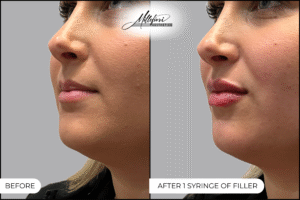Dermal fillers are a popular cosmetic treatment for enhancing facial features and restoring volume, but not all results turn out as expected. One concern patients may face is filler migration, a shift in product placement that can alter appearance and affect confidence.
Iris Graham, MMS, PA-C, is a board-certified physician assistant with over a decade of injection experience and advanced training in aesthetic medicine. She leads treatment at Millefiori Aesthetics in Melbourne, FL, combining clinical expertise with a personalized approach.
Learning what causes filler migration, and how to avoid it, can help individuals make informed decisions and achieve smoother, more natural-looking results.
What Is Filler Migration?
Filler migration happens when a dermal filler moves from the area where it was originally injected. Instead of staying in place, the product shifts, often creating puffiness, unnatural contours, or uneven shapes. This is most commonly seen in areas like:
- The lips
- Nasolabial folds
- Under the eyes (tear troughs)
When filler migrates, it can blur the definition of the treated area, sometimes making features appear distorted or overly full.
Why Filler Migration Occurs
Filler migration can happen for several reasons, including both natural movement and issues related to the injection process. Overfilling an area, using the wrong type of filler, or injecting at an improper depth can all lead to the product shifting over time. In some cases, the filler may migrate due to frequent pressure on the area, such as from touching the face, sleeping on one side, or applying skincare too aggressively.
Facial expressions and muscle movement also play a role, especially in high-motion areas like the lips. When an inexperienced injector performs treatment, the chances of migration increase. Proper technique, product choice, and injector expertise are key factors in minimizing this risk.
How to Prevent Filler Migration
The most effective way to prevent filler migration is to approach treatment with a focus on expertise and safety. Key prevention tips include:
- Choosing a skilled injector with experience in facial anatomy
- Using only FDA-approved, high-quality dermal fillers
- Avoiding excessive product in one session
- Following aftercare instructions, such as avoiding facial massages and sleeping on your back for the first few nights
Good technique and conservative volume choices are essential to achieving balanced, lasting results.
What to Do If You Notice Filler Migration
In most cases, filler migration is treatable. If changes in shape, symmetry, or texture occur, the next step is to schedule a professional evaluation. Many migrated fillers can be dissolved with an enzyme called hyaluronidase, allowing for correction and retreatment if desired.
Prompt attention and a personalized plan can help restore a more natural appearance without long-term complications.
Beautiful Results with Dermal Fillers in Melbourne, FL
If you are thinking about dermal fillers or noticing changes that could indicate filler migration, scheduling a professional consultation is the most important next step.
To speak with a specialist or book your consultation, contact us at 321-821-4778. Your refreshed, confident appearance starts with a conversation.


